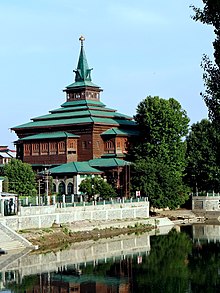Khanqah-e-Moula
| Khanqah-e-Mu'alla | |
|---|---|
خانقاہِ معلّےٰ | |
 The Khanqah on the banks of Jhelum | |
| Religion | |
| Affiliation | Islam |
| District | Srinagar |
| Region | Kashmir Valley |
| Ecclesiastical or organizational status | Active |
| Status | Active |
| Location | |
| Location | Fateh Kadal, Srinagar |
| State | Jammu and Kashmir |
| Country | India |
| Geographic coordinates | 34°05′28″N 74°48′28″E / 34.091248°N 74.807771°E |
| Architecture | |
| Founder | Sultan Sikandar |
| Completed | 1395 CE, Rebuilt 1732 CE |
| Specifications | |
| Height (max) | 38m |
| Dome(s) | 1 (turret) |
| Minaret(s) | None |
Khanqah-e-Moula, also known as Shah-e-Hamadan Masjid and Khanqah is a mosque located in the Old City of Srinagar, Jammu and Kashmir, India. Situated on the right bank of the river Jhelum between the Fateh Kadal and Zaina Kadal bridges, it was first built in 1395 CE, commissioned by Sultan Sikendar. It is one of the best examples of Kashmiri wooden architecture, and is decorated with papier mache.[1]
Construction
The mosque was commissioned by Sultan Sikandar Butshikan in 1395 CE in memory of the Islamic preacher Mir Sayyid Ali Hamadani, the central figure involved in the widespread conversion to Islam in Kashmir. Also known as Shah-e-Hamadan (the King of Hamadan), the preacher came to Kashmir from the city of Hamadan in Persia in the 14th century. He is credited for the spread of Islam in Kashmir. In 1480 AD, the shrine was destroyed due to fire. The then ruler, Sultan Hassan Shah, expanded its premises and rebuilt it. In 1731 AD, the Khanqah was again destroyed by fire and then rebuilt by Abdul Barkat Khan.
Background

There have been false claims that it was built atop a temple, whose validity has been questioned by many, and believe it to be a revisionist attempt to re-cast history as traditional Kashmiri Hindu historians, such as Kalhana, Jonaraja and Shuk Bhatt make no mention of the existence of any temple at the site of the structure. The counterclaim stemming from the fact that a Hindu religious site also exists adjacent to the shrine and the historians have suggested that the two sites have in fact always been adjacent to one another,[2] their proximity being representative of communal tolerance.[3] Kashmiri Hindus have also historically held the Khanqah in high reverence.[4]
Archaeologist R.C. Kak in Ancient Monuments of Kashmir[5] and historian P. N. K. Bamzai in Culture and Political History of Kashmir while writing about the Khanqah, do not altogether mention anything about the possibility of the existence of a temple where the present structure stands.[6] Historian Ashiq Husain Bhat further argues that re-purposing of Hindu shrines into Muslim ones wouldn’t have been unusual, given that the overwhelming majority of Kashmiris converted to Islam, and a similar conversion of the site into a church would occur were Kashmiris to convert en masse to Christianity.[2] The construction of Muslim shrines at Hindu sites has also been interpreted by some as an attempt by Kashmiri Muslim to maintain links to their Hindu past.[7]
Fire of 2017
On 15 November 2017, a fire broke out in the shrine which damaged the spire of the building. Fire tenders were brought on the scene and they managed to arrest the spread of the fire which prevented any further damage to the building.[8]
Restoration work was immediately started[9] and on 30 March 2018, a refurbished crown was successfully installed on the spire of the shrine.[10]
See also
References
- ^ "Khanqah".
- ^ a b "Maha Kali temple co-exists with Khanqah". Rising Kashmir. Retrieved 15 January 2019.
- ^ Iqbal, S. M.; Nirash, K. L. (1978). The Culture of Kashmir. Marwah Publications.
- ^ Rabbani, G. M. (1986). Kashmir, social and cultural history. Anmol Publications.
- ^ Kak, R.C. (2002). Ancient monuments of Kashmir (1st [reprint] ed.). Srinagar-190001, Kashmir: Gulshan Publishers. pp. 77–79. ISBN 81-86714-60-X.
{{cite book}}: CS1 maint: location (link) - ^ Bamzai, P.N.K. (1994). Culture and Political History of Kashmir (1st ed.). New Delhi-110002: M.D. Publications. pp. 326–27, 536–40. ISBN 81-85880-33-6.
{{cite book}}: CS1 maint: location (link) - ^ Central Asiatic Journal. O. Harrassowitz. 2010.
- ^ "Khankah-e-Moula shrine damaged in Srinagar fire". 15 November 2017. Retrieved 5 May 2019.
- ^ "Latest News From Kashmir, Breaking News, Current Headlines, Kashmir News Online | Greater Kashmir". Retrieved 5 May 2019.
- ^ "Khankah-e-Maulla gets refurbished crown". 31 March 2018. Retrieved 5 May 2019.
